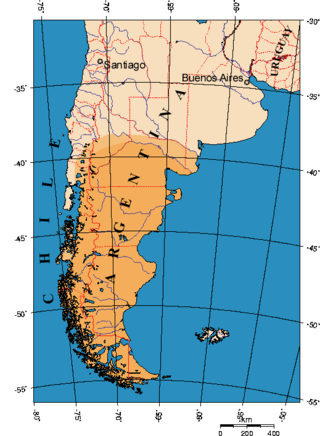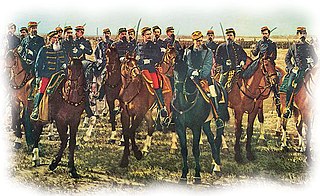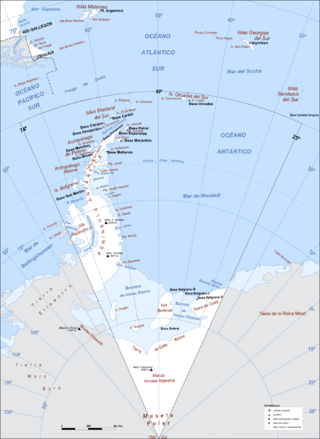
Patagonia is a geographical region that encompasses the southern end of South America, governed by Argentina and Chile. The region comprises the southern section of the Andes Mountains with lakes, fjords, temperate rainforests, and glaciers in the west and deserts, tablelands and steppes to the east. Patagonia is bounded by the Pacific Ocean on the west, the Atlantic Ocean to the east, and many bodies of water that connect them, such as the Strait of Magellan, the Beagle Channel, and the Drake Passage to the south.

The Beagle conflict was a border dispute between Chile and Argentina over the possession of Picton, Lennox and Nueva islands and the scope of the maritime jurisdiction associated with those islands that brought the countries to the brink of war in 1978.

The Conquest of the Desert was an Argentine military campaign directed mainly by General Julio Argentino Roca during the 1870s and 1880s with the intention of establishing dominance over Patagonia, inhabited primarily by indigenous peoples. The Conquest of the Desert extended Argentine territories into Patagonia and ended Chilean expansion in the region.

Cecilia Edith Rotenberg Gutkin better known as Cecilia Roth is an Argentine actress. She is the winner of two Goya Awards and a European Film Award. She is known for being an "Almodóvar girl" and the "muse" of Fito Páez during the 1990s.

Fray Mocho was the pen name for the Argentine writer and journalist José Ciriaco Alvarez. He moved to Buenos Aires first in 1876 and then again to stay in 1879 at the age of 21. He was known to his friends as "Mocho" (blunt) and later added the title "Fray". He wrote for several newspapers including El Nacional, La Pampa, La Patria Argentina, and La Razón. He also wrote for magazines such as the short-lived Fray Gerundio, El Ateneo and La Colmena Artística. He wrote essays about life in Buenos Aires in the latter part of the 19th century, including Esmeraldas (polished), Cuentos Mundanos, La vida de los ladrones célebres de Buenos Aires y sus maneras de robar and Memorias de un Vigilante. In 1898 he wrote the book En el Mar Austral.

Vicente Fidel López was an Argentine historian, lawyer and politician. He was the son of writer and politician Vicente López y Planes.

Spanish is the de facto official and administrative language of Chile. It is spoken by 99.3% of the population in the form of Chilean Spanish, as well as Andean Spanish. Spanish in Chile is also referred to as "castellano". Although an officially recognized Hispanic language does not exist at the governmental level, the Constitution itself, as well as all official documents, are written in this language.

International relations between the Republic of Chile and the Argentine Republic have existed for decades. The border between the two countries is the world's third-longest international border, which is 5,300 km (3,300 mi) long and runs from north to south along the Andes mountains. Although both countries gained their independence during the South American wars of liberation, during much of the 19th and the 20th century, relations between the countries were chilly as a result of disputes over the border in Patagonia. Despite this, Chile and Argentina have never been engaged in a war with each other. In recent years, relations have improved. Argentina and Chile have followed quite different economic policies. Chile has signed free trade agreements with countries such as China, the United States, Canada, South Korea, as well as European Union, and it's a member of the APEC. Argentina belongs to the Mercosur regional free trade area. In April 2018, both countries suspended their membership from the UNASUR.
The region of the Beagle Channel, explored by Robert FitzRoy in the 1830s, was one of the last to be colonized by Chile and Argentina. The cold weather, the long distances from other inhabited regions, and the shortage of transport and subsistence, kept it far from the governmental task.
Operación Soberanía was a planned Argentine military invasion of Chile due to the Beagle conflict. The invasion was initiated on 22 December 1978 but was halted after a few hours and Argentine forces retreated from the conflict zone without a fight. Whether the Argentine infantry actually crossed the border into Chile has not been established. Argentine sources insist that they crossed the border.

The corbeta (corvette) ARA Uruguay, built in England, is the largest ship afloat of its age in the Armada de la República Argentina, with more than 140 years passed since its commissioning in September 1874. The last of the legendary squadron of President Sarmiento, the Uruguay took part in revolutions, ransoms, expeditions, rescues, and was even floating headquarters of the Navy School. During its operational history 1874–1926 the Uruguay has served as a gunboat, school ship, expedition support ship, Antarctic rescue ship, fisheries base supply ship, and hydrographic survey vessel, and is now a museum ship in Buenos Aires. This ship may be the oldest in South America having been built in 1874 at Laird Bros. shipyard of Birkenhead, England, at a cost of £32,000. This ship is rigged to a barque sailplan. The ship's steel hull is sheathed in teak.
Mauro Andrés Olivi is an Argentine former professional footballer. He played as striker or also as an attacking midfielder.
The World Organization of Independent Scouts is an international Scouting organization for traditional Scouting.
Santiago Roth was a Swiss Argentine paleontologist and academic known for his fossil collections and Patagonian expeditions.
Río Frías Formation is a Middle Miocene geologic formation made up sedimentary rock located in Aysén Region, western Patagonia. The formation crops out along the upper couse of Cisnes River. Marsupial fossils have been found in the formation. The Friasian period in the South American Land Mammal Ages is named after the formation.
TNT Sports Argentina is a subscription television channel mainly dedicated to the broadcast of the Argentine Primera División, along with ESPN Premium, which began broadcasting on Friday, August 25, 2017, from 6:00 p.m., after the alliance of Turner and Fox by the television rights of the Argentine First Division of Argentine soccer, being replacement of the governmental program Fútbol para Todos.
Limón de Pica is an unusually acidic lime from the oasis town of Pica in Atacama Desert. Limóns de Pica have had an appellation of origin since 2010. The environment where the limes are grown has a mild microclimate that does not display the typical high temperature oscillations seen in many of the world's deserts. Six producers, compromising 20% of the agricultural output of the oasis, are organised in Oasis Pica Coop. As of 2019, the coop was working to certify its products as organic and enforce the appellation control of limón de Pica.
Palyeidodon is an extinct genus of mammal belonging to the family Toxodontidae, from the Miocene of Argentina. It contains the single species Palyeidodon obtusum.


















